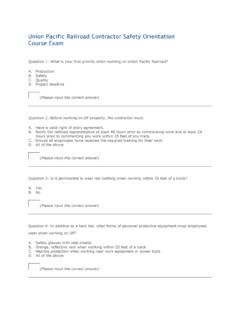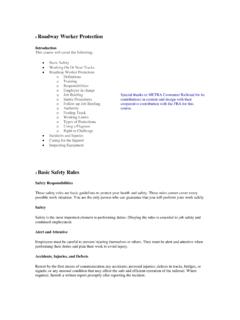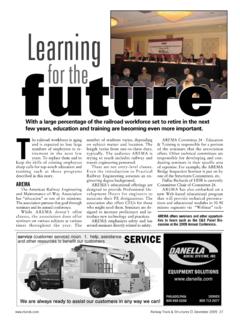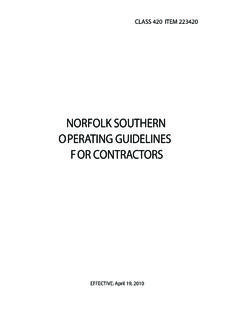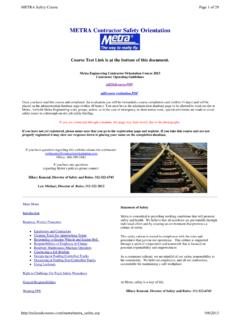Transcription of Roadway Worker Procedures for Contractor …
1 Roadway Worker Procedures for Contractor Employees working on Metro-North Property Produced by MTA Metro-North railroad Operating Rules, Safety and Training Departments January 2016 DEFINITIONS USED IN THIS MANUAL Abbreviations used throughout this manual are shown in parenthesizes. The following list defines railroad terminology that should be studied and understood. These terms will be used in subsequent sections of this manual and in the field: Adjacent Controlled Track: A controlled track whose track center is spaced 19 feet or less from the track center of the occupied track. Adjacent Tracks: A controlled or non-controlled track whose track center is spaced less than 25 feet from the track center of the track where the authority to occupy is issued. Class A Ground man: A qualified MNR Power Department employee authorized to de-energize or re-energize and ground high tension power lines.
2 Controlling Switch: A switch that is either hand or power operated, that can be lined to prevent trains or equipment from entering a track or tracks. Controlled Track: A track upon which the railroad s operating rules requires that all movements of trains must be authorized by the Rail Traffic Controller. employee : An individual who is engaged or compensated by a railroad or by a Contractor to a railroad to perform any of the duties defined in this manual. employee Responsible for Providing On-Track Protection: Metro-North railroad employee qualified in Roadway Worker Protection, Operating Rules, and Physical Characteristics designated on the Roadway Worker Safety Briefing Form (RWSB) to provide on-track safety for a particular workgroup. Employer: A railroad or a Contractor to a railroad , that directly engages or compensates individuals to perform any of the duties defined in this manual.
3 Flagman: A MNR employee designated to direct or restrict the movement of trains past a point on a track, to provide on-track protection for Roadway workers on non-controlled track. This employee may be the RWIC. Foul Time: A method of establishing working limits on controlled track in which the RWIC is notified by the RTC that no trains will operate within a specific segment of controlled track until the Roadway Worker reports clear of the track. Fouling a Track: The placement of an individual or item of equipment in such proximity to a track that the individual or equipment could be struck by a moving train or on-track equipment, or in any case is within four feet of the field side of the near running rail. Inaccessible Track: A method of establishing working limits on non-controlled track by physically preventing entry and movement of trains and equipment.
4 Lookout: A qualified Roadway Worker employee assigned to provide train approach warning to a maximum of two employees. Maximum Authorized Speed (MAS): The maximum speed authorized by the Operating Rules and Timetable. Metro-North railroad (MNR) Non-Controlled Track: A track not under the control of an RTC. On-track Protection: The means provided to employees to prevent them from being struck by trains or other equipment, provided for by operating rules that govern track occupancy by personnel, trains, and on-track equipment. -1- Rail Traffic Controller (RTC): The employee in charge of the movement of trains and equipment on main and other tracks specified in the employee Timetable. railroad Bridge Worker : A railroad employee or an employee of a Contractor to MNR responsible for the construction, inspection, or maintenance of a bridge whose assigned duties, if performed on a bridge, include: inspection, testing, maintenance, repair, construction, or reconstruction of the track; bridge structural members; operating mechanisms and water traffic control systems; or signal, communication, or train control systems integral to that bridge.
5 Right of Way: The limits of railroad property ownership on either side of tracks. Roadway Worker : A railroad employee or an employee of a Contractor to MNR, whose duties include: inspection, construction, maintenance or repair of track, bridges, Roadway , signal and communication systems, electric traction systems, Roadway facilities, or Roadway maintenance machinery on or near track with the potential of fouling a track, and employees responsible for on-track protection. Roadway Work Group: Two or more Roadway workers organized to work together on a common task. Roadway Worker in Charge (RWIC) Third (3rd) Rail man: A qualified MNR Power Department employee authorized to de-energize/re-energize the 3rd rail. Train Approach Warning: A method of establishing on-track protection by warning Roadway Workers of the approach of trains or equipment in sufficient time for them to move to or remain in a place of safety.
6 Watchmen/Advance Watchmen: Qualified MNR employees who warn other Roadway workers of the approach of trains or equipment, in order to allow the Roadway workers to safely clear to the predetermined place of safety before trains or equipment reach the work site. This MNR employee may not perform any other duties. working Limits: A segment of track within defined limits, upon which trains or equipment may operate only as authorized by the designated RWIC. -2- Roadway Worker SAFETY ORIENTATION The following safety orientation is intended to assist Contractor employees in understanding the safety requirements of the railroad environment. Failure to follow these safety instructions could result in equipment or property damage, serious injury, or death. The MNR rules and instructions in this manual apply to all employees working on Metro-North property.
7 Employees of a Contractor , consultants, or other entities that are not employees of Metro-North railroad are required to review and understand this safety orientation prior to working on MNR property. The Contractor s employer shall designate an individual who will be responsible at all work locations to insure compliance with MNR rules and instructions. Such individual must be fluent in the English language and capable of communicating (including translating as necessary) instructions from the RWIC or other MNR representative to the Contractor employees on the property. This individual must be on the scene at all times while work is being performed or any Contractor employees are on or about the railroad right-of-way. Adherence to the safety rules is a condition of working MNR property. Contractor equipment must be inspected by MNR no less than every 3 months and must be in safe working condition to prevent injuries and delays to the trains.
8 Contractors must have written permission before placing or putting into service equipment on or near the tracks. It is the Contractor s responsibility to coordinate all inspections of equipment prior to use on the right-of-way. MNR requires Contractor employees to be properly rested and to abstain from any activity which would affect the safe and efficient performance of their duties. The company does not expect Contractor employees to incur any risk or commit any unsafe act nor does it condone such actions. Proper safety habits must be practiced and guidance given to new Contractor employees working on MNR property. Contractor employees must not depend on the watchfulness of others and be alert for their own safety. All incidents, accidents, near misses, and unusual occurrences, regardless of how insignificant they may seem at the time, shall be reported immediately to your MNR representative.
9 In the event someone becomes injured or ill, they shall receive immediate first aid or medical attention. As soon as the situation is stabilized, the Contractor or consultant shall immediately notify MNR of the incident. PERSONAL ELECTRONIC DEVICES The use of a personal electronic device by Contractor employees is strictly prohibited when on or about the right of way and tracks. A personal electronic device includes mobile telephone or another electronic device to conduct a verbal communication; place or receive a telephone call; send or read an electronic mail message or text message; play a game; navigate the Internet; play, view, or listen to a video; play, view, or listen to a television broadcast; play or listen to a radio broadcast other than a radio broadcast by a railroad ; play or listen to music; execute a computational function, or to perform any other function that is not necessary for the health or safety of the person and that entails the risk of distracting the employee from safety related duties.
10 -3- PERSONAL SAFETY Work Clothing Requirements To safely perform their duties, employees must wear suitable clothing and footwear and not work shirtless. (Where duties do not require arm protection, short sleeve or ''T'' type shirts are permitted). Employees are prohibited from wearing: (a) Neckwear that may become entangled or caught in machinery or equipment. (b) Jewelry that may become entangled or caught in machinery or equipment or contact energized electrical circuits or apparatus. (c) Clothing badly torn or loose enough to be hazardous. Loose or baggy trousers, cuffs, or bottoms must be secured to prevent flapping, catching, or dragging. (d) Short trousers, cut-offs, and tank tops. (e) Clothing or gloves saturated with oil, grease, or other flammables. (f) Head or ear covering which interferes with vision or hearing.

